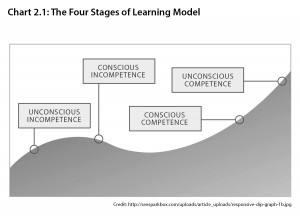 This is the third of four posts on tips for training your subject matter expert to be polished in front of learners.
This is the third of four posts on tips for training your subject matter expert to be polished in front of learners.
To review from our previous weeks, train-the-trainer sessions – or TTT sessions – need to include three main topics:
- The material to be taught
- Vocal quality and body position
- Classroom management
This week, we will explore vocal quality and body position to ensure your material can be seen, heard and remembered.
Presentation Training is Essential
Except for a largely untrained rock band experience, I didn’t have any real experience in front of an audience until I spent a few years with Toastmasters. For anyone who wants to truly understand presentation, Toastmasters provides the ultimate education. Not everyone has the time or proximity to take advantage of a Toastmasters chapter, but everyone who gets in front of a group as a speaker, trainer or facilitator needs the skills it teaches.
To get any real value out of a program like Toastmasters or a certified facilitation course, you need months, if not years, to become truly polished and comfortable. Let’s assume you don’t have that kind of time to get ready, or get someone else ready, to present a class or facilitate a meeting. Now what?
When you are training your trainers, if your SME can nail down a few basic behaviors the material can be seen, heard and remembered. I recommend reinforcing basic speaking skills even for seasoned trainers during your train-the-trainer session. Refreshers are good for everyone. Even seasoned SME-trainers can use a little reminding about basic presentation skills.
Be Seen, Be Heard, Be Clear
Entire books have been written on speaking well and body language. For brevity, I just want to arm you with a few highlights that you can use in a quick TTT module. If you only have time to emphasize a few things, there are two main components to speaking, training and facilitating: voice quality and body posture.
1. Vocal Quality: Simply put, you must be able to be heard. This means accounting for people with different abilities to hear, as well. Don’t assume everyone has excellent hearing; they don’t. So even if you think your volume is fine, ask if everyone can hear you. Adjust seating if necessary.
Be sure to articulate your words and speak at a comfortable pace. Most of us have some regional accent or may speak too quickly when we are nervous. All the more reason to slow it down just one notch and pronounce consonants like “p’s” and “t’s” clearly that compensate somewhat for regional variations in pronunciation. This goes double if you have attendees who are non-native speakers. Keep your word choices simple so everyone understands what you are talking about. Even a room full of PhDs may have different specialties and you may be speaking across disciplines. Your goal is to be understood easily by as many people as possible.
When attendees speak, often their comments get lost. If you are leading a discussion or taking questions, be sure to repeat the questions before you answer them or sum up comments made by attendees. When it is obvious a speaker’s volume is too low to be heard, you can also ask them to repeat their comment so everyone can hear them. “Jane, that’s a great point. Would you mind repeating it to make sure everyone heard it?” It is more common than not that your attendees have not spoken loudly enough to be heard by everyone.
Unamplified Situations: In small rooms, you may be unamplified so make sure to speak loudly and clearly without shouting. Want to know if everyone can hear you? Ask them. Ask them early. Ask them again a bit later just to make sure you haven’t lost them. I have a habit of dropping my voice when I am engrossed in the material and I need to constantly remind myself to keep my voice level up.
Amplified Situations: Make sure you do a sound check both before the presentation or class and right after everyone arrives. Place your mic appropriately on your body so you can move your head and body naturally. You don’t want to talk into your collar! When the room is full, do one last check before you begin because people and their clothing absorb sound. You might have been loud and clear in a large empty hall during your sound check, but you may be muffled with a roomful of people during the real thing. Also, if you move around when you speak, be aware of the placement of your mic so it doesn’t create feedback.
2. Body positioning: Your attendees need to see you and they need to see your material if you are using a video or slide presentation. Don’t compete with your slides for attention. If they contain vital information, step aside so they can be read by everyone. Sometimes, with a small room or due to some other logistics, it is hard to find a place to stand where you aren’t obstructing someone’s view of critical material. If that’s the case, move around enough so everyone gets a chance to see your presentation. Also, just like with vocal volume, ask if everyone can see. Again, offer to adjust seating and ask if people would like to move closer.
Everyone needs to see you – not just any side of you but your face. Your face communicates a lot of your message. In fact, if you have attendees who have trouble hearing you, they will be getting critical information by seeing your face. Again, this may mean moving around depending on the size and orientation of the room. As much as possible, do not turn your back on your attendees at any time. It not only obscures your facial expressions, it is impolite.
Finally, body posture communicates most of your message. I’ve seen studies that say body language makes up 80% or more of our message. Smile. Make eye contact with your attendees. Keep an open posture, meaning don’t put your hands in your pockets or fold your arms. Gesture using your arms from the center of your body. Open palms and open arms are good signals to your audience that you want to communicate with them.
One last little hint: just because a presenter is comfortable in front of the class doesn’t necessarily mean they are effective. Reinforce these basic skills to make sure they are not only comfortable with themselves, but that your trainers are making the learning experience comfortable for the attendees, too. When the attendees can see and hear the material, you have accomplished the first step to them remembering what you have told them!
What are your favorite train-the-trainer tips? Pet peeves? Share your thoughts in the comments below.




